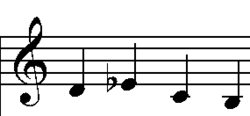Motif DSCH
- Motif DSCH
-
Les lettres DSCH désignent un motif musical utilisé par le compositeur russe Dmitri Chostakovitch en référence à lui même, comme le fit Jean-Sébastien Bach avec le motif BACH. Il est constitué des notes « ré - mi bémol - do - si », dont la transcription dans les notations allemandes donnent ses initiales D. Sch. (la transcription allemande de son nom est Dmitri Schostakowitsch).
NB: L’appellation DSCH de ce thème provient de l'écriture allemande "D - Es - C - H" des notes "ré - mi bémol - do - si", puisque le mi bémol (en allemand Es prononcé S) renvoie au début du nom Schostakowitch. Une jolie trouvaille pour un thème qu’il a su admirablement développer dans plusieurs œuvres, à commencer par le splendide huitième quatuor, composé en trois jours dans la ville de Dresde ruinée par son effroyable bombardement.
Ce motif apparaît dans plusieurs de ses œuvres, comme la Symphonie n° 10 en mi mineur, le Quatuor à cordes n°8 en ut mineur, le Concerto pour violon n°1 en la mineur, le Trio avec piano n º2, la Symphonie n°15 en la majeur.
Wikimedia Foundation.
2010.
Contenu soumis à la licence CC-BY-SA. Source : Article Motif DSCH de Wikipédia en français (auteurs)
Regardez d'autres dictionnaires:
DSCH — Motif DSCH Le motif DSCH Les lettres DSCH désignent un motif musical utilisé par le compositeur russe Dmitri Chostakovitch en référence à lui même, comme le fit Jean Sébastien Bach avec le motif BACH. Il est constitué des notes « ré mi bémol … Wikipédia en Français
DSCH motif — The DSCH motif DSCH is a musical motif used by the Russian composer Dmitri Shostakovich to represent himself. It is a musical cryptogram in the manner of the BACH motif, consisting of the notes D, E flat, C, B natural, or in German musical… … Wikipedia
Motif (music) — For other uses, see Motif (disambiguation) and Motive (disambiguation). A phrase originally presented as a motif may become a figure which accompanies another melody, as in the second movement of Claude Debussy s String Quartet (1893) … Wikipedia
DSCH (Dmitri Shostakovich) — DSCH is a musical motif used by the Russian composer Dmitri Shostakovich to represent himself, in the manner of the BACH motif of Johann Sebastian Bach. It consists of the notes D E flat C B, or D Es C H in German notation, standing for his… … Wikipedia
DSCH — may stand for: DSCH motif, a musical motif used by the Russian composer Dmitri Shostakovich to represent himself. DSCH is also the name of a Russian journal and a publishing house devoted to the composer. Concerto DSCH. a ballet made by Alexei… … Wikipedia
Motivo DSCH — El motivo DSCH. DSCH es un motivo musical utilizado por el compositor ruso Dmitri Shostakóvich para representarse a sí mismo. Se trata de un criptograma musical, como lo fue el motivo BACH de Johann Sebastian Bach. El motivo DSCH ( … Wikipedia Español
Passacaglia on DSCH — The Passacaglia on DSCH is a large scale composition for solo piano by the British composer Ronald Stevenson. It was composed between 24 December 1960 and 18 May 1962, except for two sections added on the day of the first performance on 10… … Wikipedia
BACH motif — In music, the BACH motif is the sequence of notes B flat, A, C, B natural . Bach s use of this cruciform melody in reference to himself extended to its inversion, retrograde, retrograde inversion, and all transpositions thereof. This four note… … Wikipedia
Concerto DSCH — is a ballet by Alexei Ratmansky choreographed for the New York City Ballet to the music of Dmitri Shostakovich s Concerto No. 2 in F Major, Op. 102 (1957). The premiere took place on Thursday, May 29th, 2008 at the New York State Theater, Lincoln … Wikipedia
DEsCH — Motif DSCH Le motif DSCH Les lettres DSCH désignent un motif musical utilisé par le compositeur russe Dmitri Chostakovitch en référence à lui même, comme le fit Jean Sébastien Bach avec le motif BACH. Il est constitué des notes « ré mi bémol … Wikipédia en Français

